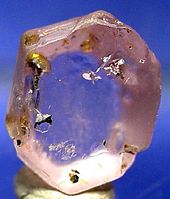Taaffeite: Difference between revisions
m Reverted 1 edit by 134.196.61.90 (talk) to last revision by ClueBot NG. (TW) |
|||
| Line 35: | Line 35: | ||
==Discovery== |
==Discovery== |
||
its all fake who is reading pls click on another website |
|||
Taaffe bought a number of [[precious stones]] from a jeweller in October 1945. Upon noticing inconsistencies between the taaffeite and spinels, Taaffe sent some examples to B. W. Anderson of the Laboratory of the [[London Chamber of Commerce]] for identification on 1 November 1945. When Anderson replied on 5 November 1945, he told Taaffe that they were unsure of whether it was a [[spinel]] or something new; he also offered to write it up in ''[[Gemologist]]''.<ref name="Anderson"/> |
|||
[[File:Magnesiotaaffeite-2N2S-76500.jpg|thumb|left|upright|Specimen from [[Ratnapura]], Sri Lanka]] |
[[File:Magnesiotaaffeite-2N2S-76500.jpg|thumb|left|upright|Specimen from [[Ratnapura]], Sri Lanka]] |
||
Revision as of 13:17, 21 January 2018
| Taaffeite | |
|---|---|
 Magnesiotaaffeite-2N’2S (Mg3Al8BeO16) | |
| Allgemein | |
| Kategorie | Oxide minerals |
| Formula (repeating unit) | BeMgAl4O8 |
| Strunz classification | 4.FC.25 |
| Crystal system | Hexagonal |
| Crystal class | Dihexagonal pyramidal (6mm) Trigonal dipyramidal (3m) (magnesiotaaffeite-6N'3S and ferrotaaffeite-6N'3S) |
| Identification | |
| Color | Colorless, greyish violet, violet red, red, greenish, light green, pink violet, mauve |
| Crystal habit | Prismatic, alluvial grains |
| Twinning | By reflection on (0001)? |
| Cleavage | Imperfect/fair/absent |
| Fracture | Conchoidal |
| Mohs scale hardness | 8–8.5 |
| Luster | Vitreous |
| Streak | White |
| Diaphaneity | Transparent to translucent |
| Specific gravity | 3.60–3.61 |
| Optical properties | Uniaxial |
| Refractive index | nω = 1.722, nε = 1.777 |
| Birefringence | δ = 0.055 |
| Pleochroism | Weak |
| References | [1][2] |
Taaffeite (/ˈtɑːfaɪt/; BeMgAl4O8) is a mineral, named after its discoverer Richard Taaffe (1898–1967) who found the first sample, a cut and polished gem, in October 1945 in a jeweler's shop in Dublin, Ireland.[3][4] As such, it is the only gemstone to have been initially identified from a faceted stone. Most pieces of the gem, prior to Taaffe, had been misidentified as spinel. For many years afterwards, it was known only in a few samples, and it is still one of the rarest gemstone minerals in the world.[5]
Since 2002, the International Mineralogical Association-approved name for taaffeite as a mineral is magnesiotaaffeite-2N'2S.
Discovery
its all fake who is reading pls click on another website

Properties
In 1951, chemical and X-ray analysis confirmed the principal constituents of taaffeite as beryllium, magnesium and aluminium,[6] making taaffeite the first mineral to contain both beryllium and magnesium as essential components.[1]
The confusion between spinel and taaffeite is understandable as certain structural features are identical in both. Anderson et al.,[7] classified taaffeite as an intermediate mineral between spinel and chrysoberyl.[8] Unlike spinel, taaffeite displays the property of double refraction that allows distinction between these two minerals.
Usage
Because of its rarity, taaffeite is used only as a gemstone.[9]
Formation and occurrence
Taaffeite occurs in carbonate rocks alongside fluorite, mica, spinel and tourmaline. This extremely rare mineral is increasingly found in alluvial deposits in Sri Lanka[10] and southern Tanzania,[1] as well as lower grade taaffeite in limestone sediments in China.[8]
See also
References
- ^ a b c Thomas, Arthur (2008) Gemstones: properties, identification and use. New Holland Publishers. p. 74. ISBN 1-84537-602-1
- ^ Magnesiotaaffeite, Mindat
- ^ Dept. Mineralogy, British Museum, June 7 1951 Taaffeite, a new beryllium mineral, found as a cut gem-stone. Retrieved February 2015
- ^ Papers and proceedings of the International Mineralogical Association. General meeting, Mineralogical Society of America, Volume 9, p. 502
- ^ Collings, Michael R (2009). Gemlore: An Introduction to Precious and Semi-Precious Stones (2nd Ed). p. 152. Wildside Press LLC. ISBN 1-4344-5702-8
- ^ Read, Peter G. (2005). Gemmology. Butterworth-Heinemann. p. 5. ISBN 0-7506-6449-5.
- ^ Anderson, B.W., Payne, C.J., and Claringbull, G.F., (1951) Taaffeite, a new beryllium mineral, found as a cut gemstone. Mineralogical Magazine 29, pp. 765–772
- ^ a b Institut mineralogii, geokhimii, i kristallokhimii redkikh ėlementov (1966). Geochemistry and mineralogy of rare elements and genetic types of their deposits, Volume 2. Institut mineralogii, geokhimii i kristallokhimii redkikh elementov. (English Version Publisher: Israel Program for Scientific Translations). pp. 77–79.
- ^ Amethyst Galleries Inc.
- ^ Geological abstracts, Issues 1–7259 (1992). Elsevier/Geo Abstracts, p. 565
